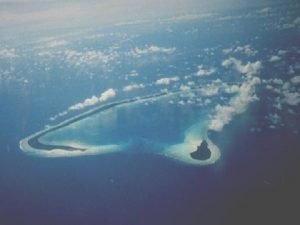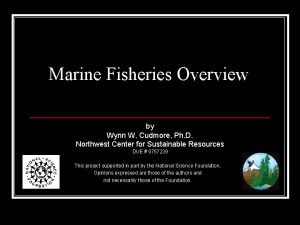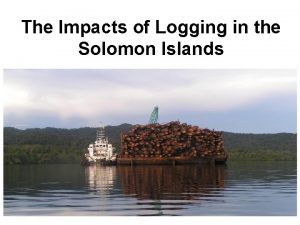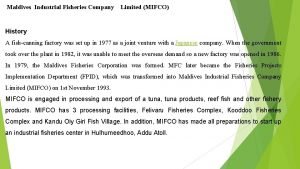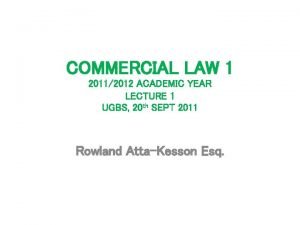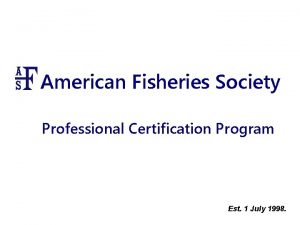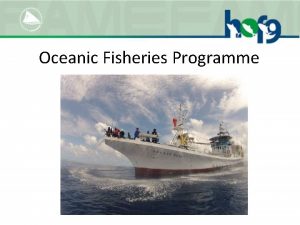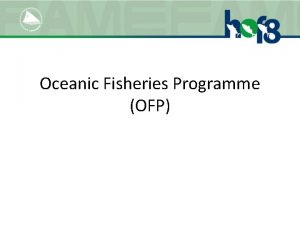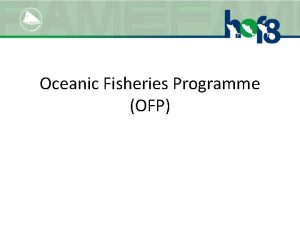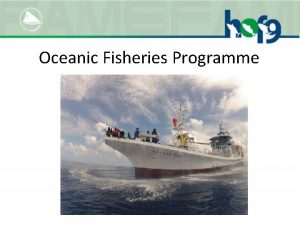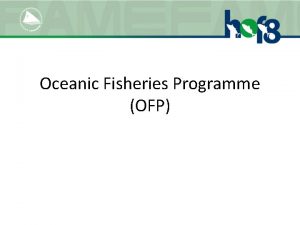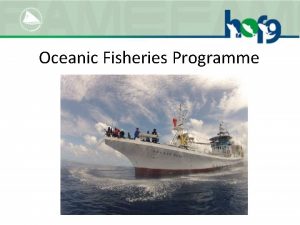History of the Pacific Islands Oceanic Fisheries Management







- Slides: 7

History of the Pacific Islands Oceanic Fisheries Management Project 1997: South Pacific International Waters Strategic Action Programme formulation (Ridge-to-reef and oceanic combined) 2000 -2005: Oceanic Fisheries Management Project (Scientific Assessment and Monitoring) 2005 -2011: PIOFMP 1 – Ratification of the Convention and establishment of the Commission 2014 -2018: PIOFMP 2 - Implementation of the work and activities of the Commission and its related instruments The OFM projects have confirmed that the main and significant transboundary issues for the LME and the WCPFC area are the oceanic fisheries issues, particularly in the context of climate change In this context, the PIOFMP II project identified the need to develop and adopt a specific TDA focusing on Oceanic Fisheries Management with migratory tuna stocks as the primary transboundary concern marine. iwlearn. net

Mainstreaming climate change and ecosystem-based approaches into the sustainable management of the Living Marine Resources of the WCPFC Background Ø TDA drafted in 2017 – 18 and presented to the PSC and Forum Fisheries Committee in May 2018 Ø SAP drafted in 2018 and presented to PSC in November 2018 Ø SAP endorsed by FFC Officials and Ministers in May and June 2019 Ø PIF drafted in 2019 and now ready for consideration by GEF Focal Points Project Information • Implementing Agency – UNDP • Executing Agency – FFA (Pacific Islands Fisheries Forum Agency) • Expected Submission Date September 2019 (into Work Programme) • Duration – 60 Months • GEF Focal Area – International Waters • Core Indicator - Area of marine habitat under improved practices (excluding MPAs) = Approx 3. 6 Million marine. iwlearn. net

WCPFC Region in Context marine. iwlearn. net

Predictive modelling of changes in fisheries distribution marine. iwlearn. net

From TDA to the Strategic Action Programme The TDA identified the top three priority areas that were required to be addressed through a Strategic Action Programme as: 1. 2. 3. Remaining weaknesses in management and compliance, both ‘in-zone’ and on the high seas Impacts from climate change and associated concerns due to excessive carbon emissions and lack of adopted global mitigation procedures Inadequate application of an ecosystem-based management approach In order to address these, the SAP has been structured to focus on: Ø Improvements and Strengthening of Management Strategies and Mechanisms for Sustainability of living marine resources through an ecosystem-based management approach Ø Strengthening and expanding the scientific knowledge base to support improved understanding and management of the ecosystem and its living marine resources in the WCPFC area to support food and economic security Ø Capacity Building and Training for Improved Management of the Ecosystem and its Living Marine Resources in the WCPFC Area Ø Pursuit and realisation of the relevant targets and indicators for the UN Sustainable Development Goal 14 which support 1 -3 above marine. iwlearn. net

Mainstreaming climate change and ecosystem -based approaches - The Project Approach Component 1: Implementation fisheries Outcome 1. 1 Adaptive and sustainable ecosystem-based management of fisheries and associated natural resources with an emphasis on response to climate change impacts and focusing on the benefit to the PICs Outcome 1. 2 Improved capacity and expertise for overall fisheries management at both the national and regional level as well as to expand opportunities for PICs engagement in fisheries markets technology Component 2: Innovative management approach to regional fisheries Outcome 2. 1 Improved on-board monitoring of catch, bycatch and movement of catch (transshipping and landing), MCS and data analysis to significantly reduce IUU fishing Outcome 2. 2 Greater monitoring and control of FADs to optimise returns from target stocks and reduce bycatch and other ecological impacts marine. iwlearn. net

Mainstreaming climate change and ecosystem -based approaches - The Project Approach gy. Component regional 3: A effects on the ecology and fisheries of the region Outcome 3. 1 Strengthened data capture, modelling and assessment feeding into management responses to climate-induced impacts on fisheries Outcome 3. 2 New strategies in place to respond to socioeconomic changes and food security issues related to climate change (i. e. improving community subsistence and small-scale commercial fisheries) Component 4: Knowledge Management Outcome 4. 1: Knowledge Management, Communication and Awareness implemented and outreaching to WCPFC stakeholders as well as the global community marine. iwlearn. net


